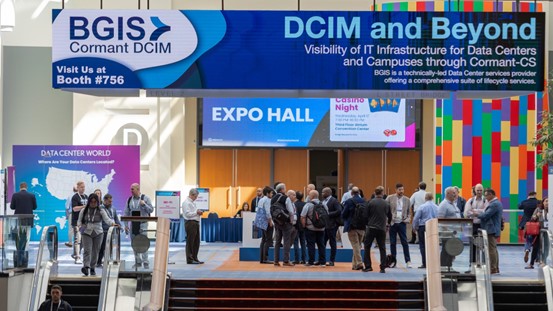As data centers become increasingly complex, managing the infrastructure efficiently is crucial for maintaining performance, reducing energy consumption, and ensuring sustainability. One of the most effective ways to achieve this is through DCIM (Data Center Infrastructure Management). This article delves into the nature of DCIM, its working principles, and the benefits it can offer and some common DCIM solutions.
You can attend industry events such as Data Center World HK (15-17 Jul 2025) to learn more about the most current trends, technologies, and best practices shaping the Data Center Asia Pacific region.

What is DCIM?
DCIM is a centralized system that collects data from sensors, hardware, and software to monitor key aspects of a data center’s operations, such as power usage, cooling, and environmental conditions. It helps data center managers make informed decisions for optimal performance.
How Does DCIM Work?
DCIM collects real-time data on temperature, power consumption, and equipment performance. It then analyzes this data to provide actionable insights, allowing managers to optimize cooling, power usage, and server performance, which in turn enhances overall efficiency.
Key Features of DCIM Solutions
- Real-time Monitoring: Tracks the performance of critical infrastructure components like servers, power, and cooling systems.
- Asset Management: Keeps track of hardware and equipment, including its location, status, and lifecycle.
- Energy Management: Monitors and optimizes power usage to reduce energy costs and improve efficiency.
- Environmental Monitoring: Tracks environmental conditions such as temperature, humidity, and airflow to ensure optimal conditions for hardware.
- Predictive Analytics: Uses data to forecast potential issues and prevent downtime through proactive maintenance and optimization.
- Reporting and Dashboards: Provides customizable reports and visual dashboards to monitor key performance indicators (KPIs) and overall data center health.
DCIM helps improve data center efficiency by optimizing power, cooling, and hardware use, leading to cost savings, reduced downtime, and enhanced uptime. It supports sustainability through energy-efficient operations and simplifies management by centralizing control for easier monitoring and performance optimization. In addition, unlike traditional methods which may require manual intervention and can lead to delays in resolving problems, DCIM monitor all aspects of the facility in real time and offers more streamlined and efficient management.
How to Choose the Best DCIM Solutions?
When selecting the best DCIM solution for your data center, you can follow this practical guide listed below.
1. Assess Your Needs & Growth Plan
- Size of your data center: Are you managing a small server room or a large-scale facility? Choose a DCIM that can scale with your growth.
- Future expansion: Ensure the solution can handle more devices, sensors, and infrastructure as your operations grow.
2. Assess Your Needs & Growth Plan
- Current infrastructure: Check if the DCIM integrates with your current monitoring tools (e.g., UPS, cooling systems, network management).
- API access: Look for DCIM with APIs that allow integration with other systems you use, such as ticketing tools, CMMS (Computerized Maintenance Management Systems), or cloud services.
3. Energy Management & Reporting
- Power consumption tracking: Choose a DCIM with detailed energy monitoring (e.g., real-time data on power usage by server, cooling unit, etc.). Look for energy consumption breakdowns at a granular level (rack, row, or even individual equipment level).
- Energy optimization: Look for PUE (Power Usage Effectiveness) tracking to ensure you’re meeting your energy efficiency goals. The solution should automatically suggest adjustments to reduce wasted energy.
4. Real-Time Monitoring & Alerts
- Customizable alerts: Ensure the DCIM gives you real-time notifications when issues like overheating, power spikes, or equipment failures occur. This can prevent unplanned downtime.
- Automation: Select a DCIM that can automatically adjust cooling or power when certain thresholds are met, reducing manual intervention.
5. Ease of Use
- Dashboard: Go for a DCIM that offers an intuitive dashboard that your team can use immediately. Look for customizable views with easy-to-read graphs and metrics (e.g., temperature, power usage).
- User access control: Make sure the DCIM allows you to set permissions for different roles (engineers, management, etc.) so each user has access only to the information they need.
6. Vendor Support & Training
- Technical support: Ensure the DCIM provider offers strong customer support, including 24/7 availability, especially for mission-critical data centers.
- Training & onboarding: Check if the vendor offers training to help your team get the most out of the system, especially if it’s a complex platform.
7. Cost vs. ROI
- Pricing model: Understand if the solution is subscription-based, one-time payment, or based on the number of devices monitored. Compare this to the expected ROI, such as reduced energy costs and fewer system downtimes.
- Free trial or demo: Test the system before committing. Ask for a demo or free trial to ensure it suits your operations.
8. Security Features
- Data protection: Ensure the DCIM has robust security protocols to protect your data. Look for features like two-factor authentication, data encryption, and regular security updates.
Conclusion
In conclusion, DCIM is crucial for optimizing data center performance and efficiency. It provides real-time monitoring and insights to reduce costs, improve uptime, and support future growth.
Don’t miss out on the opportunity to explore the latest innovations in data center technologies at Data Center Asia 2025 in Hong Kong from 15-17 July 2025. Join industry leaders and professionals to discover cutting-edge solutions and network with key decision-makers in the Asia-Pacific region. Book your space or register as an industry visitor today!



